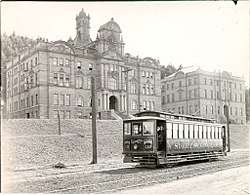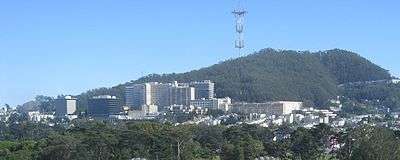UCSF School of Medicine
The UCSF School of Medicine is the medical school of the University of California, San Francisco and is located at the base of Mount Sutro on the Parnassus Heights campus in San Francisco, California. Founded in 1864 by Hugh Toland, it is the oldest medical school in California and the western United States. The school is affiliated with the UCSF Medical Center, which U.S. News & World Report ranked as the 7th-best overall medical center in the United States and the #2 hospital in California in 2019.[1] UCSF faculty have treated patients and trained residents since 1873 at the San Francisco General Hospital and for over 50 years at the San Francisco VA Medical Center.
 | |
Former names | Toland Medical College |
|---|---|
| Type | Medical School |
| Established | 1864 |
Parent institution | University of California, San Francisco |
| Dean | Talmadge E. King, Jr. |
Academic staff | 2,643 |
| Students | 1,428 |
| 152 | |
| Alumni | 8,342 |
| Location | , 37°45′46″N 122°27′29″W |
| Website | http://medschool.ucsf.edu |
UCSF is the top public recipient of biomedical research grants from the National Institutes of Health (NIH), with over $500 million in funding, and 998 NIH grants.[2] It is recognized as one of the premier medical schools in the United States. US News & World Report ranks UCSF School of Medicine 5th in research training and 2nd in primary care training.[3] In 2019, it ranked #1 in the world for clinical medicine in the annual Academic Ranking of World Universities.
The UCSF School of Medicine has 7 major sites throughout the San Francisco Bay area, and is composed of 28 academic departments, 8 organized research units, and 5 interdisciplinary research centers. The main site is at the Parnassus Heights campus, which is home to the UCSF Medical Center and the Langley Porter Psychiatric Institute. The UCSF Medical Center at Mission Bay opened in 2015 and is home to the UCSF Benioff Children's Hospital, UCSF Betty Irene Moore Women's Hospital and the UCSF Bakar Cancer Hospital.
History
The school was founded in 1864 as the Toland Medical College by Hugh H. Toland, a South Carolina surgeon who found great success and wealth after moving to San Francisco in 1852.[4] A previous school, the Cooper Medical College of the University of Pacific (founded 1858), entered a period of uncertainty in 1862 when its founder, Elias Samuel Cooper, died.[5] In 1864, Toland founded Toland Medical College and the faculty of Cooper Medical College chose to suspend operations and join the new school.[5] In 1873 the college affiliates with the University of California. Together with the School of Dentistry, they became UCSF's first two “Affiliated Colleges” and were followed by the College of Dentistry in 1881 and the UC Training School for Nurses in 1907.[6]
The University of California was founded in 1868, and by 1870 Toland Medical School began negotiating an affiliation with the new public university.[7] Meanwhile, some faculty of Toland Medical School elected to reopen the Medical Department of the University of the Pacific, which would later become Stanford University School of Medicine.[8] Negotiations between Toland and UC were complicated by Toland's demand that the medical school continue to bear his name, an issue on which he finally conceded.[7] In March 1873, the trustees of Toland Medical College transferred it to the Regents of the University of California, and it became The Medical Department of the University of California."[7]

Initially, the three Affiliated Colleges were located at different sites around San Francisco, but near the end of the 19th Century interest in bringing them together grew. To make this possible, San Francisco Mayor Adolph Sutro donated 13 acres in Parnassus Heights at the base of Mount Parnassus (now known as Mount Sutro). The new site, overlooking Golden Gate Park, opened in the fall of 1898, with the construction of the new Affiliated Colleges buildings. The school's first female student, Lucy Wanzer, graduated in 1876, after having to appeal to the UC Board of Regents to gain admission in 1873.[9][10]
The university gained more independence in the 1960s when it started to be seen as a campus in its own right instead of as the medical center of the UC system. The four departments were renamed as "School of ..." and the UCSF Graduate Division was founded in 1961. Further along this line, in 1964 the institution obtained full administrative independence under the name University of California, San Francisco Medical Center, becoming the ninth campus in the University of California system and the only one devoted exclusively to the health sciences.
A pivotal moment in UCSF history was the deal between Vice-Chancellor Bruce Spaulding and San Francisco Mayor Willie Brown for the development of the Mission Bay campus in 1999. Renowned scientist J. Michael Bishop, recipient of both the Lasker Award and Nobel Prize in Medicine (together with UCSF professor Harold Varmus), became the eighth Chancellor in 1998. He oversaw one of UCSF's major transition and growth periods, including the expanding Mission Bay development and philanthropic support recruitment. During his tenure, he unveiled the first comprehensive, campus-wide, strategic plan to promote diversity and foster a supportive work environment. During this time, UCSF also adopted a new mission: advancing health worldwide™.[11] The 2010s saw increased construction and expansion at Mission Bay, with the Smith Cardiovascular Research Building, the UCSF Medical Center at Mission Bay, and the Benioff Children's Hospital in 2010, the Sandler Neuroscience Center in 2012, and Mission Hall and the Baker Cancer Hospital in 2013. In 2012, the school opened the UCSF Anatomy learning center. The Children's Hospital was named after Mark Benioff, who donated $100 million toward the new facility.[12] In 2015, the Mission Bay campus saw the grand opening of the new UCSF Medical Center at Mission Bay, a 289-bed integrated hospital complex dedicated to serving children, women and cancer patients. The school started the new Bridges curriculum in 2016 with the class of 2020.
Faculty
The School of Medicine has 2,498 full-time faculty. There have been six Nobel Prize winners over the past six decades, and among its 2018 faculty members are:[13]
- 43 members of the National Academy of Sciences
- 84 members of the National Academy of Medicine
- 18 Howard Hughes Medical Institute investigators
- 32 NIH Innovator and Young Innovator Awards
- 64 members of the American Academy of Arts & Sciences
List of deans
- Hugh H. Toland (1864-1870)
- R. Beverly Cole (1870-1875, 1878-1882)
- Alonzo A. O'Neill (1875-1878)
- Robert A. Maclean (1882-1899)
- Arnold A. D'Ancona (1899-1913)
- Hebert C. Moffitt (1913-1919)
- Wallace I. Terry (1919-1920)
- David P. Barrows (1921-1923)
- Lionel S. Schmitt, acting (1923-1927)
- R. Langley Porter (1927-1936, 1939-1940)
- W. McKim Marriott (1936)
- Chauncey D. Leake (1937-1939)
- Robert Gordon Sproul (1940-1942)
- Francis S. Smyth (1942-1954)
- John B. Lagen (acting) (1954-1956)
- John B. De C. M. Saunders (1956-1963)
- William O. Reinhardt (1963-1966)
- Stuart C. Cullen (1966-1970)
- Charles T. Carman (1970)
- Joseph B. Martin (1989-1993)
- Haile Debas (1993-2003)
- David A. Kessler (2003-2007)
- Sam Hawgood, (2007-2014)
- Bruce Wintroub, Interim (2014-2015)
- Talmadge E. King, Jr. (2015–present)
References
- "2019-20 Best Hospitals Honor Roll and Medical Specialties Rankings".
- "UCSF Is Top Public Recipient of NIH Research Funding for 6th Consecutive Year". UC San Francisco. Retrieved 2017-07-15.
- "University of California--San Francisco". U.S. News & World Report L.P. Retrieved 3 February 2019.
- Hugh Huger Toland (1806–1880), UCSF, Accessed October 6, 2010.
- A History of UCSF: San Francisco's First Medical Institutions, UCSF, Accessed October 6, 2010.
- "1868-1898 - Introduction - A History of UCSF". History.library.ucsf.edu. Retrieved 2017-07-15.
- A History of UCSF: University Affiliation, UCSF, Accessed October 10, 2010.
- Chronology of the Stanford University Medical Center, Stanford School of Medicine, Accessed June 11, 2007.
- Chen, Jeffrey. "140 Years Later: The First Female Graduate of UCSF". UCSF School of Medicine. Retrieved December 18, 2013.
- "A History of UCSF". The Regents of the University of California. Retrieved November 26, 2013.
- "John Michael Bishop - Biography - A History of UCSF". history.library.ucsf.edu.
- "UCSF Children's Hospital receives $100 million gift to build new hospital". UC San Francisco.
- "Facts & Figures | UCSF School of Medicine". medschool.ucsf.edu.
